1767. Young Mr Hand, a Huguenot, flees from Flanders to escape religious persecution by the French. He is not alone. Ever since the Revocation of the Edict of Nantes in 1685, (which had granted French Protestants freedom of religious practice) thousands of Huguenots had fled to nearby Protestant countries – and taken their skills with them.

A formal coat for a diplomat. The first thing once notices is its weight and rigidity. This is about status not comfort.
Hand arrived in London, set up a small lace-making business and began to sell gold lace to military tailors. He worked hard and it paid off; in due course, the business expanded to include the design and manufacture of military badges and other accoutrements. Hand & Co was soon well-respected and used by top tailors in Savile Row as well as Military tailors.
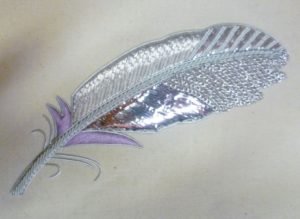
Exquisite embroidery of a feather – from the front

The intricacy of the threads at the back shows that it is hand made
1950s. Enter Stanley Lock, a talented embroidery designer at the specialist embroiderers C E Phipps & Co. On Mr Phipps’ retirement in 1958, Mr Lock bought the business and renamed it S. Lock, Ltd. The merging of the two companies in 2001 allowed the new Hand & Lock company to share their skills and explore new commercial possibilities.
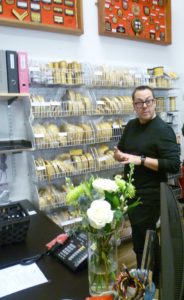
Robert McCaffrey, Communications Manager and our guide. Here he is showing us how to tell if braid is made from genuine gold thread – it is colder to the touch
What instantly struck me as I was shown into the Hand & Lock workshops in Margaret Street, London, just behind Oxford Circus, was how colourful it was. The Communications Manager, the cheerful and friendly Robert McCaffrey, showed us round. Hand & Lock is not your usual austere office. It is open plan, informal and colourful; there is a vase of white roses on a table, and Robert’s Mr Cool coffee mug on his desk.

Gold military lace
The first thing I learnt was that military lace is quite different from the delicate silk lace of a wedding dress. I would have described it as gold braid. It is thick and heavy and it’s used to indicate status on a military garment. And with it go a number of other military accoutrements, such as gold epaulettes, aiguillettes, frogging on jackets, and so on, all of which are complicated and need specialist work. I couldn’t help thinking that full military uniform in the 19th century was impractical, heavy, and highly visible. From the enemy’s point of view, any soldier wearing it was an easy target. On the other hand, wearing such a splendid uniform probably raised a soldier’s morale. As one Major during the Peninsular War (1808-1815) put it: ‘One is never too well dressed when the cannon roars.’
Britain was almost continually at war from the date of Hand’s arrival in London. Even after Napoleon’s defeat in 1815, there were dozens of small wars all over the expanding British Empire; in India, Africa, and the Far East – and plain khaki for overseas combat did not come in until 1897. Hand & Co were kept busy.
Nowadays, Couture is a large part of Hand & Lock’s work. They embroidered the wedding dresses of a number of Royal brides, including Lady Diana Spencer’s wedding dress which was embroidered by S. Lock & Co with thousands of sequins and over 10,000 thousand pearls.

1920s Beading on a Flapper dress, inspired by a vintage dress bought by Kate Moss
A recreation of a wonderful example of beading, part of a vintage 1920s Flapper dress, once owned by the wife of the dashing Hollywood star, Errol Flynn, hangs on the wall. The dress was found in a sorry state of repair: grubby, with loose beading, and covered in cigarette burns in Portobello Road market by Kate Moss. It was Hand & Lock who recreated it for her, cleverly incorporating the cigarette burns, but as little circles of crystal beads rather than unsightly splodges of charred tobacco.
Robert asked me to take it down and hand it round. It is a beautiful piece of work; the long dangly beads swing loose and must have looked terrific when Mrs Flynn was doing the Charleston.

Lily displays the JUST MARRIED logo on the yoke of a Denim Jacket
We move through to where the embroidery designer, Lily Goulding, works. She shows us an example of personalized clothing designed on the computer and machine embroidered. This is a very popular way of personalizing a garment and it can be done quickly, within a day or so. The only thing Lily has to worry about, she told us, is to make sure that the letters are absolutely level and equidistant. (Though I’m sure she’s being much too modest.)
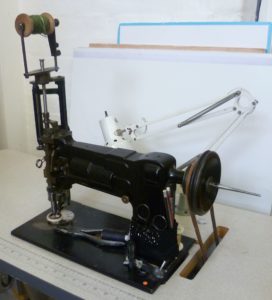
Hand-guided Sewing Machine
The next room is much bigger with large windows. There are a couple of hand guided sewing machines, including the one above. It looks like a vintage model but it can still do the most amazing work.
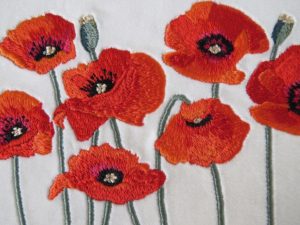
Poppies design, perhaps for curtains, or a pair of cushions, done on a hand-guided sewing machine. (Photo courtesy of Hand & Lock)
Hand & Lock also repair and restore important artefacts, such as a church altar cloth or an antique ceremonial banner. We watched as an almost threadbare stuffed heraldic lion which had been removed from its tattered background cloth and carefully re-stitched onto a new backing was unobtrusively repaired. This requires considerable historical scholarship, as well as expertise, patience and a steady hand.
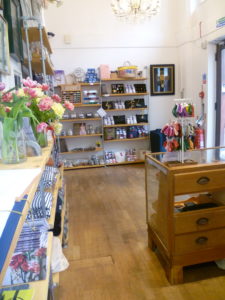
The Hand & Lock shop
The Hand & Lock shop is like a mini Aladdin’s cave. Here you can buy all sorts of lovely things; an embroidered flower for a hat, perhaps, or your initials to go onto a handbag.
I really enjoyed seeing round this fascinating workplace. And my grateful thanks to Robert McCaffrey for being such an excellent and entertaining guide.
www.handembroidery.com
Photos by Elizabeth Hawksley, unless otherwise stated.
Elizabeth Hawksley
Please share this page...
Wonderful! I had no idea military braid was called lace!
Neither had I, Jan. However, having corrected us on the subject, our guide them proceeded to call the stuff ‘braid’ which, after all, is what it is! According to my French Dictionary, lace in French is ‘dentelle’ but there is a distinction between the delicate material we trim dresses with and laces which tie up a lady’s corset. All rather confusing.
What a fabulous place. I like that note about gold thread being colder to the touch. Those uniforms must have been so heavy to wear. But they look splendid.
I was asked to try on the Diplomat’s coat and sashay down the room to demonstrate its properties; not easy as it was heavy and unwieldy. I think the most any gentleman wearing it could do would be to stand about looking, as you say, splendid!
Thanks for posting about your interesting visit, Elizabeth. As someone who can barely sew a straight seam, I am full of admiration for people who can do complicated needlework and these examples are amazing! Not that I’d actually want to wear anything covered in gold lace or acres of beading, sounds very uncomfortable even if splendid to look at…. rather like pieces of big, showy jewellery which I also love looking at but wouldn’t enjoy wearing.
Thank you for your comment, Gail. I know what you mean – some of it is a bit over the top;gilding the lily. Having said that, I have to confess that men in formal dress can look terrific – if they have the figure for it.
Fascinating article, thanks!
Thank you, Sasha, much appreciated. I enjoyed visiting Hand & Lock and learning about their unusual skills, and seeing how much hard work goes into every thing they do. Everyone, obviously, really loved their work, and that was very cheering.